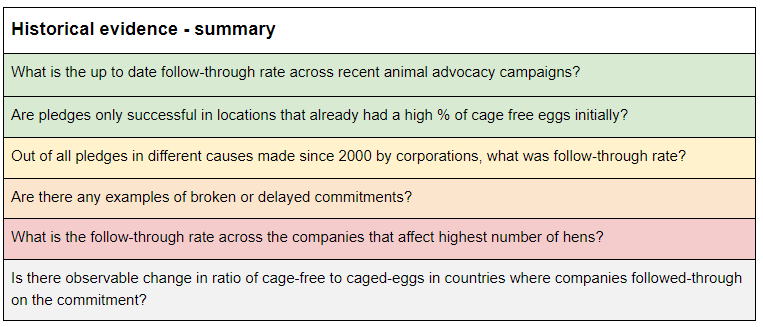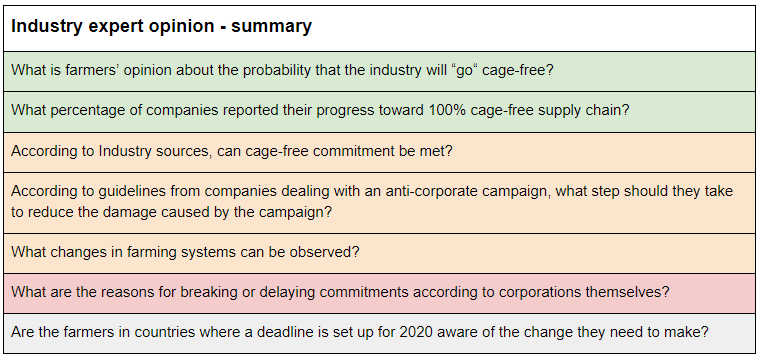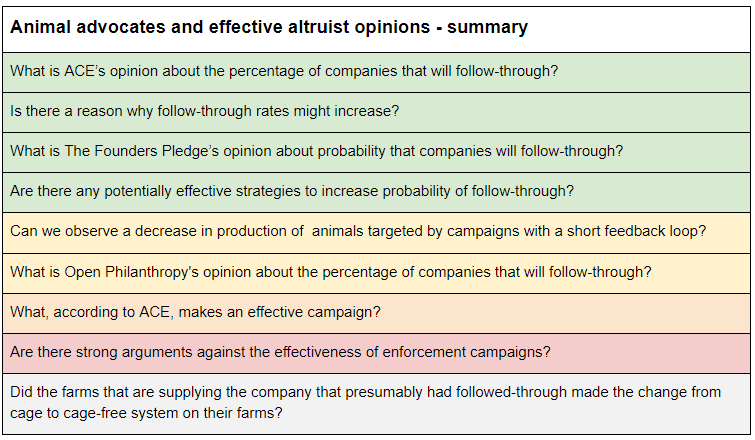The following report is a part of ongoing research by Charity Entrepreneurship looking into corporate outreach as a potential approach used to implement asks.
The full report and answers to the research questions are available for download here.
Introduction
If most corporations tend to follow through with their corporate social responsibility pledges, starting a new charity that campaigns for welfare improvements for animals would be one of the highest impact opportunities out there. But what if only a tiny fraction do? Then, it might not be worth investing in. This is why one of the key crucial considerations, when considering the launch of a new corporate outreach campaign, is the ability to enforce the pledges and ensure that companies follow through on their commitments to improve animal welfare. There are some concerns that commitments have been broken, or will be, and therefore the impact of past campaigns is significantly reduced. To estimate the expected value of launching a new corporate campaign, we need to first estimate the probability of companies following through with their commitments . We approached answering this question using a cluster approach, looking at the issue using many different sources of evidence: historical evidence, industry expert opinions, animal advocacy and effective altruism expert opinions, and studies. Below, we offer a summary of conclusions from this research. The color coding represents the type of update each group of evidence gave us. Green denotes a generally positive update (making us more confident in the odds of corporate follow through), yellow stands for a neutral update, orange for a minor negative update, and red for a more negative update. Gray is where information was unavailable. Taking into account all the evidence, I estimated that on average ~44% of companies will follow through on the welfare commitments.
Research questions




Research findings can be found in the full report.
Conclusions
Using the principle of indifference and assigning equal probability to all possible distributions of the follow-through rate, in response to evidence presented above, I came to the following conclusion about the probability distribution of % of companies that will follow-through:

A 39% - 50% confidence interval is going to be used to model cost-effectiveness of launching another corporate campaign. It is not an estimate about effectiveness of past corporate campaigns on egg-laying hens and broilers issues!
The full model can we seen here. You can copy it and insert your inputs on the weight of evidence and strength of direction of a given parameter.


When it comes to the step between research questions and the probability distribution, full research, answering each question, can be seen in the full report. In the report, we also address some of the concerns you have with the judgement calls on each of the “qualitative” parameters.
Each update incorporates the weight we put on this factor, the directionality and strength. Those factors, again, rely on other information. With the example, you cited ”what ACE thinks makes an effective campaign” vs “probability that all companies defect in a Prisoner's Dilemma scenario". For example, ACE’s opinion on the importance of public support when launching corporate campaigns is formed based on the intervention report they have researched in November 2014, and as they currently claim “is not up to our current standards.”. The landscape has changed since then. As of recent, we can observe that there is a strong track record of successful corporate campaigns in countries where the society didn’t have sympathetic views toward animals (e.g. Lithuania or Japan). I think we can rely more and more on rigorous and generalizable conclusions from research on real-life examples and on the application of game theory to predict the behaviour of the companies.
I agree I wish we had enough time to flesh out the reasoning for each of the factors. Sadly, due to limited time we are constantly having to make trade-offs about whether we should put time into explaining the reasoning more deeply to the broader community vs discussing with the CE candidates vs researching more to get a deeper internal understanding. We generally plan on going deeply into these factors with the specific entrepreneurs looking to start this project or others, who are going to work/are working in the field in the near term, but not publish much more on the topic publicly after our full report.